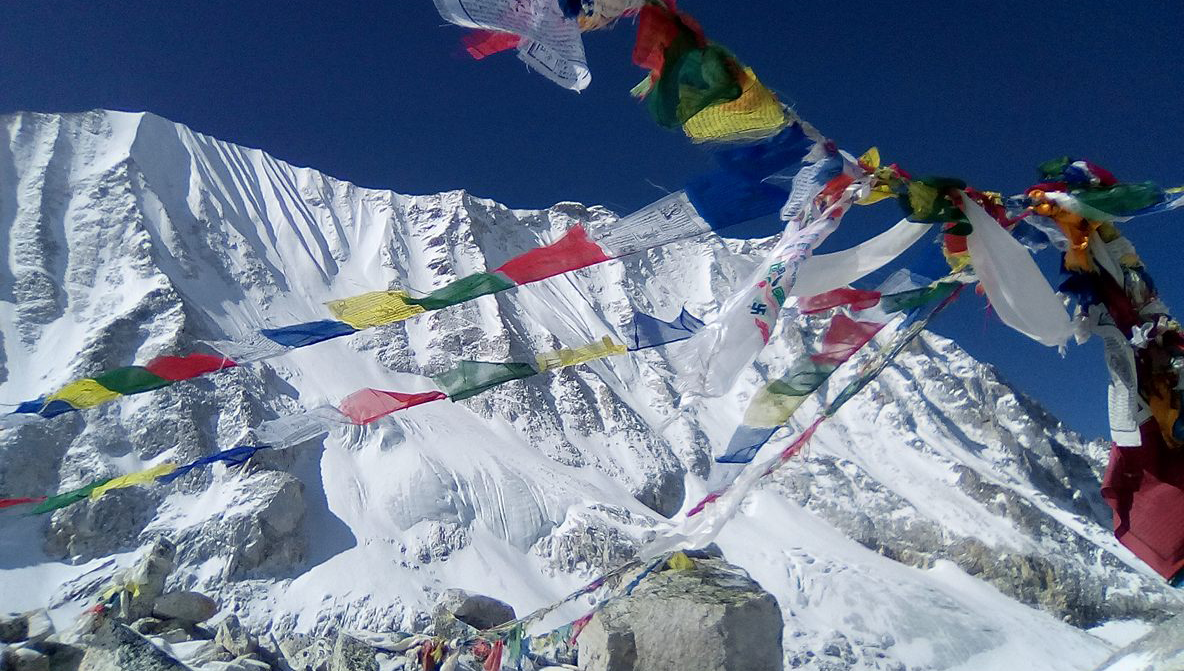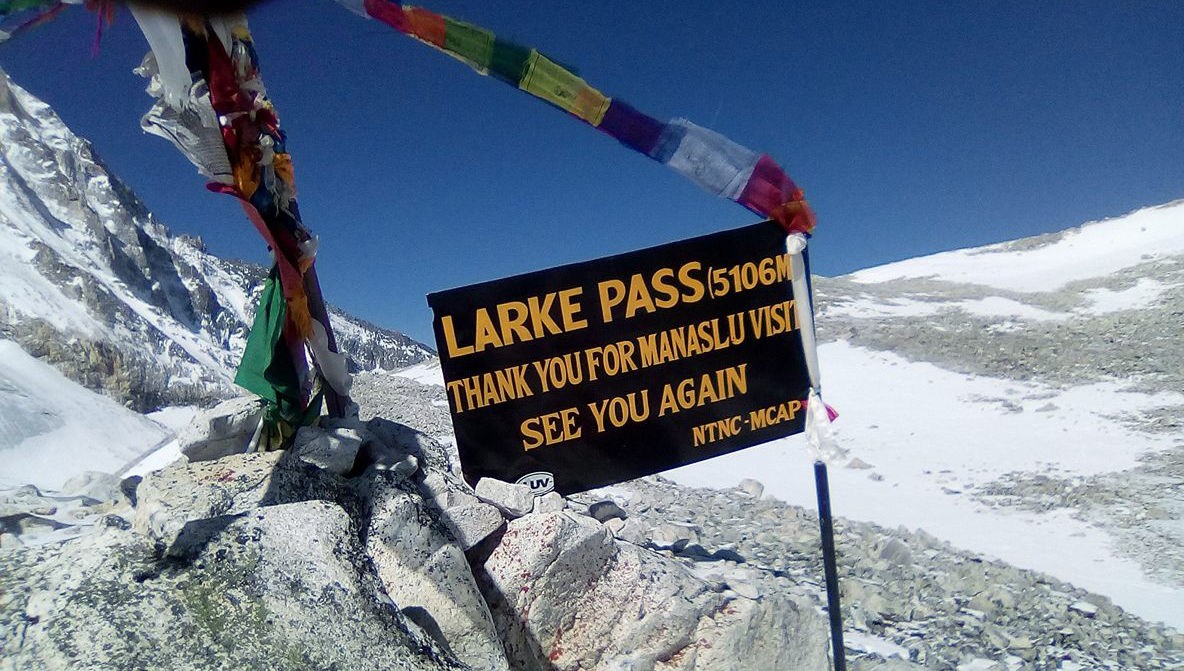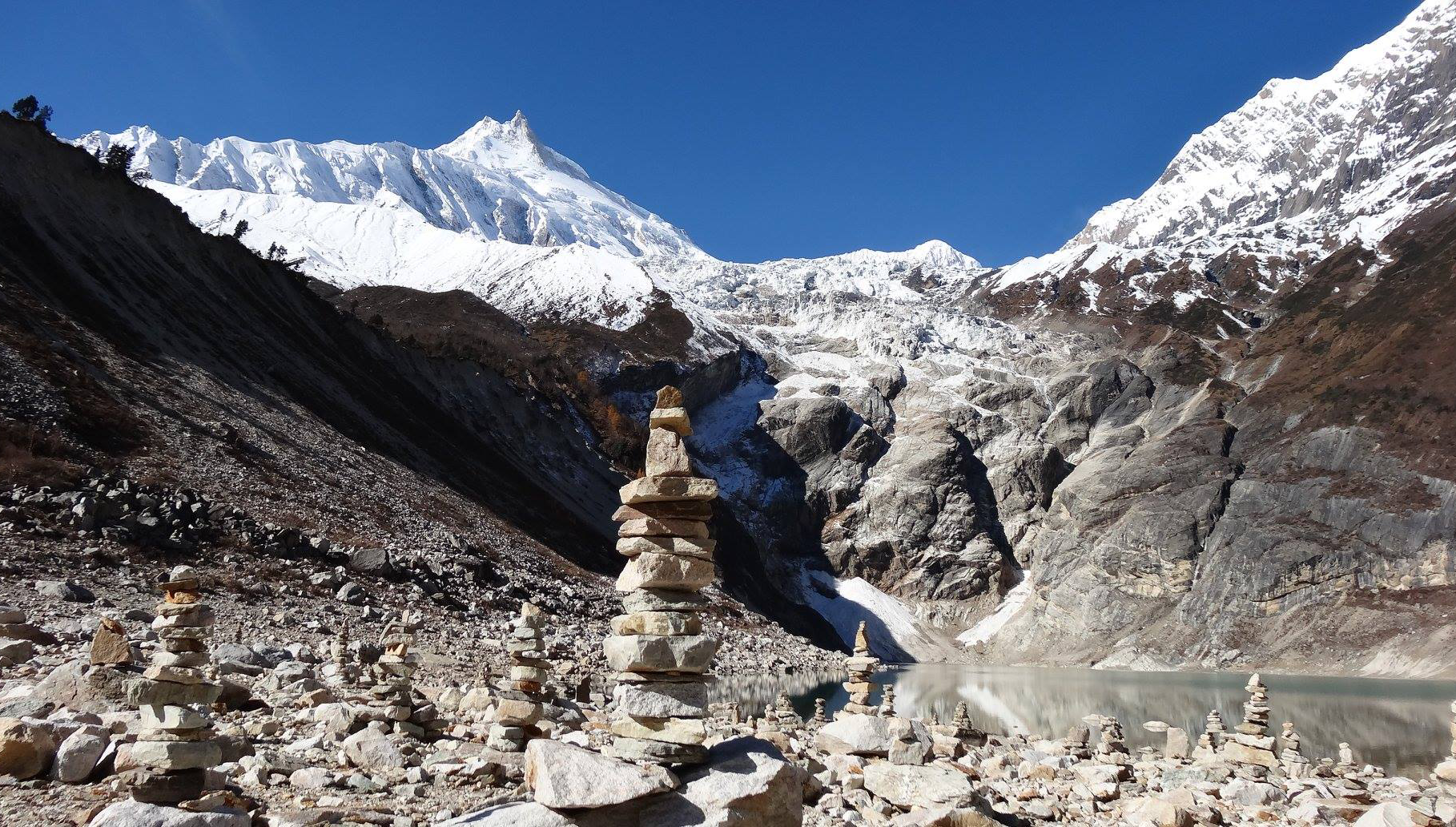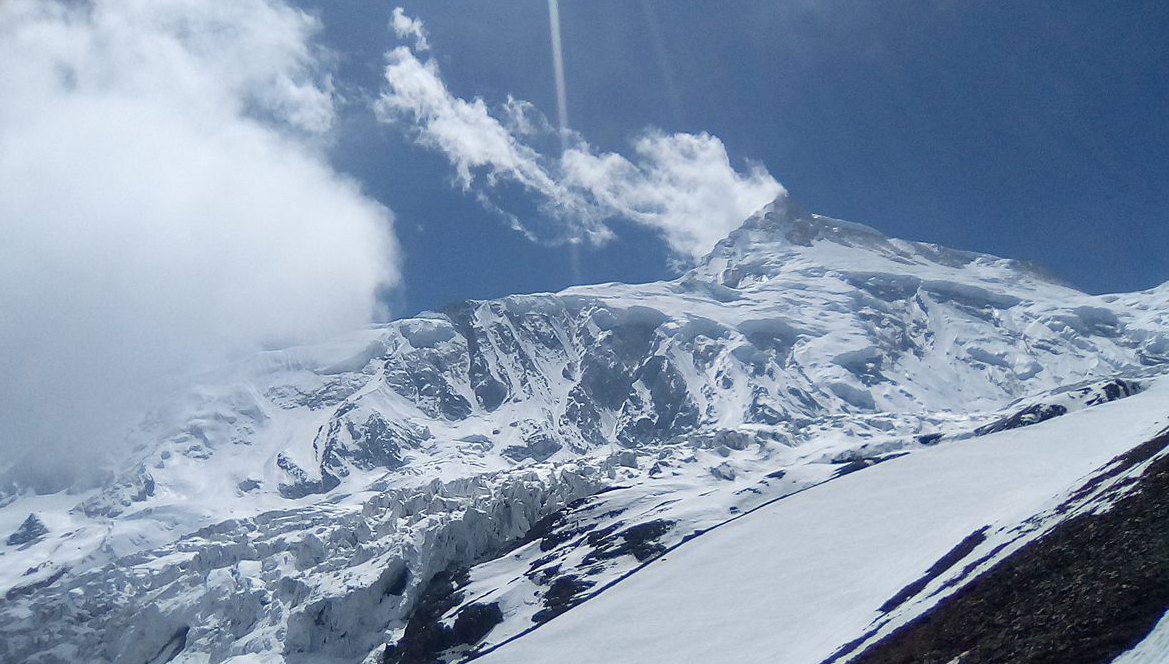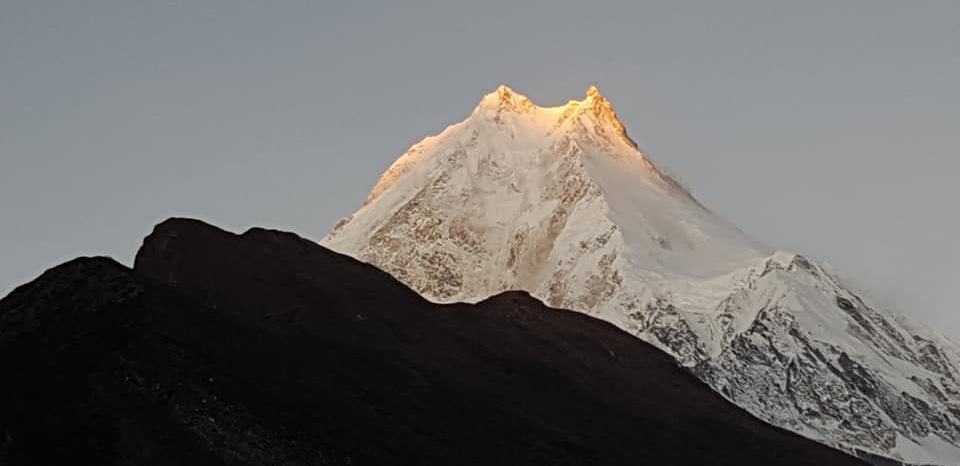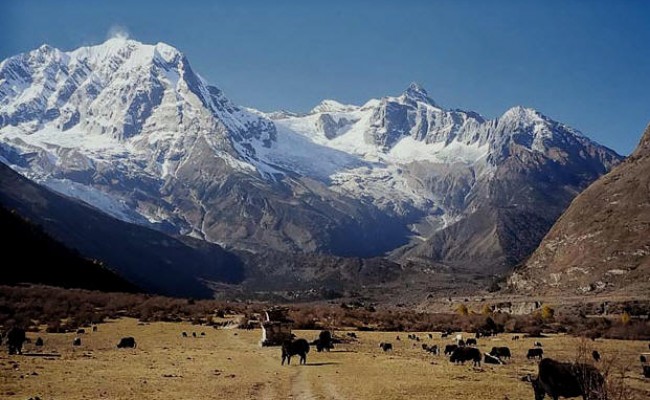Manaslu Larke Pass Trek
Manaslu Larke Pass Trek is the ultimate off-the-beaten trekking path of Nepal in the Manaslu region. It takes you to the higher Himalayas at the border between Nepal and Tibet. Manaslu Larke Pass Trek is an adventure for well-versed trekkers around the world. Trekking this route you will have an opportunity to explore the Manaslu region.
Manaslu region is the least traveled destination as it is isolated from modern facilities making it an actual challenge to deal with the Himalayas. You will travel across diverse vegetation, and landscapes and experience authentic culture with a view of the Manaslu, the 8th highest peak in the world en route to beautiful Larke La Pass (5160m).
Manaslu region is a restricted area that needs a permit from Nepal Government and a well-trained guide for the trek. This route to Manaslu was only opened in 1992 for tourists around the world. Hence, trekkers can witness the unchanged culture and lifestyle of the locals in the villages here. Manaslu along Larke Pass district is well known to have unimaginable scenes, rough and slow toppedslow-topped slops. Descending from the Larke La Pass the trail lights up incredible timberland of pines, magnolia trees, rhododendron, and oaks to Bimthang. The route passes Dharapani to reach Annapurna Circuit Trails. Trek continues toward Besisahar and offers amazing scenery of Mt. Lamjung with beautiful Tibetan villages. Manaslu Larke Pass encompasses the finest adventurous places with magnificent scenery for trekkers. This trek is gaining popularity as a daring trek to take in place of trekking in the Annapurna region. With the guidance of the Himalaya Sanctuary, discover the treasures of Manaslu Larke Pass Trek.
Day 01: Arrival in Kathmandu [1,300m/4,264 ft]
Day 02: Kathmandu: Sightseeing and Trek Preparation
Day 03: Drive Kathmandu to Soti Khola (710m) 7- 8hrs
Day 04: Soti Khola to Machha Khola (870m) 5-6hrs
Day 05: Machhe Khola to Jagat (1340m) 5-6hrs
Day 06: Jagat to Deng (1860m) 5-6hrs
Day 07: Deng to Namrung(2630m)
Day 08: Namrung to Samagaou (3360m) 6-7hrs
Day 09: Acclimatization rest in Samagaou,
Day 10: Trek from Samagaon to Samdo (3690m ) 4-5hrs
Day 11: Trek from Samdo to Larkya La Phedi (4460m.)4-5hrs
Day 12: Trek from Larkya La Phedi to Larkya La (Pass) (5135m.) to Bimthang (3590 m) 7-10hrs
Day 13: Bhimtang to Tilije (2360m) 4-5hrs
Day 14: Tilije to Dharapani (1860m)
Day 15: Dharapani to Kathmandu
Day 16: Departure Day
Day 01: Arrival at Tribhuvan International Airport (TIA), Kathmandu (1300m)
After you landed at the airport, one of the representatives from Himalaya Sanctuary Adventure will be there to receive you. Our private cab will pick you up at the respective hotel in Thamel. After some rest, we will meet up for a brief introduction and consult on some strategies for the trek. Overnight at a hotel in Kathmandu.
Day 02: Kathmandu Sightseeing and Trek Preparation:
You will explore the Kathmandu Valley today. We will visit the UNESCO world heritage sites located in Kathmandu Valley. We start with Pashupatinath, one of the most important Hindu shrines of Lord Shiva in entire Asia. The second destination will be Boudhanath Stupa, the holiest place for Buddhists and the overall structure of the stupa represents peace and enlightenment. The third and last destination will be Kathmandu Durbar Square, also named Hanuman Dhoka Durbar. Palace used to be the residence of the royal family. Return to the hotel for some rest. In the evening, we will assist you in trek preparation. Overnight in Kathmandu.
Include Meals: Breakfast
Day 03: Drive Kathmandu to Soti Khola (710m) 7- 8hrs
Early morning drive from Kathmandu to Arughat, and then to Soti Khola. It’s a scenic drive witnessing the beautiful landscape on a hill highway. In a few hours, we will reach Dhading Besi and head toward Arughat. Arughat is famous for shopping areas where people come across remote villages from Manaslu Gorkha and Dhading. Drive from Arughat to Soti Khola offers a majestic view of mountains and snow-capped hills. Overnight in Soti Khola.
Include Meals: Breakfast, Lunch, and Dinner.
Day 04: Soti Khola to Machha Khola (870m) 5-6hrs
Early morning, the trek started following the Budi Gandaki River ascends to the Kyoropani route, and descends again to the river at the convergence of the tributary of Soti Khola. Pass some villages, turned to the hillside till we reach the broad valley. Across from the large side, the stream passes into Budi Gandaki. Passing the Lapu Besi, belonging to the paved farmland. Descend again along the sandy riverside below to the precipitous, rocky valley side. We ascend again toward Machha Khola (1300m). Overnight in Machha Khola.
Include Meals: Breakfast, Lunch, and Dinner.
Day 05: Machha Khola to Jagat (1340m) 5-6hrs
Resuming the trek from Machha Khola, walk up to the small village of Khola Bensi. From here we will continue further to reach Tatopani (hot springs). After a brief rest here we will continue on the main trail. We head toward the valley sides steepen to reach Jagat, switching the bank way of a suspension bridge. The trail is challenging and exposed in places. We march toward Doban and push forward to Lauri. From Lauri, we cross the stream through a suspension bridge and ascend to Jagat. Overnight in Jagat.
Include Meals: Breakfast, Lunch, and Dinner.
Day 06: Jagat to Deng (1860m) 5-6hrs
The early morning trek initializes with descending to the riverside and ascending a hill to reach Salleri. Salleri treats you with a majestic view of Sringi Mountain (7187m). We will cross the suspension bridge of Budi Gandaki again to continue upstream to the gorge. Continue crossing the river three more times and ascend from one to another hill. It is quite a difficult route to continue uphill toward Philim and to Ekle Bhatti. Finally, reach the village of Deng after passing the ridge section. Deng village lies an altitude (1860m). Overnight at lodge in Deng.
Include Meals: Breakfast, Lunch, and Dinner.
Day 07: Deng to Namrung (2630m)
We will start the trek from Deng to pass the Lana village. Witness the lifestyle reflecting Tibetan culture throughout today’s trek passing by chortens and Mani Walls. Mani stones are the signs of the Buddhist religion used as a form of prayer in Tibetan Buddhism. It will take about four hours to follow ascend and descend the path to reach the village of Ghap. Climbing upstream from Ghap takes us into high mountain territory with a majestic view. We will get to see more Mani walls and cross multiple high-suspension bridges. March up, cross the bridge and ascend to cross the huge stream to reach Sho (3000m). Sho village offers a magnificent view of the Manaslu Peak. We will continue forward to cross a small stream to reach Namrung. A panoramic view of Shringi Himal (7161m) and Ganesh Himal (7422m) can be witnessed from Namrung. Overnight in the tea house.
Include Meals: Breakfast, Lunch, and Dinner.
Day 08: Namrung to Samagaon (3360m) 6-7hrs
Trek starts to reach Lho (3150m). Lho is a small village with an old Tibetan monastery holding the art and culture in its architecture, sculptures, and Murals. You will leave the village beside a trail decorated with prayer flags and Mani Walls continuing on the main trail. Pass Lho witnessing a beautiful view of Ganesh Himal (7424m) following the right section of the riverbank. Continue on the main trail with the view of Peak 29, to reach Samagaon near the Tibetan border. Overnight in Samagaon.
Include Meals: Breakfast, Lunch, and Dinner
Day 09: Acclimatization rest in Samagaon:
Day for taking some rest in Samagaon and exploring the village. Samagaon is an amazing village surrounded by fantastic views of snow-capped peaks. For the excellent scenery of Samdo (Pang Phuchuli) with some glaciers and mountains. You can also hike up to Manaslu Base Camp and witness the Lake of Ice called Birendra Kaunda. Return to Samagaon. Overnight in the teahouse.
Include Meals: Breakfast, Lunch, and Dinner
Day 10: Trek from Samagaon to Samdo (3690m) 4-5hrs
Resume the trek early morning following the Budhi Gandaki River upstream. Trek passes through a windy valley and desert path to Samdo. The Tibetan border is just 4 km away from Samdo though it’s strictly prohibited to pass the border. Samdo offers you the blissful scenery of Mt. Manaslu and several glaciers and mountains. Overnight in Samdo.
Include Meals: Breakfast, Lunch, and Dinner
Day 11: Samdo to Larke Phedi (4460m) 4-5hrs
Trek starts from Samdo through the rocky and zigzag trail to Dharmashala or Larke Phedi. Larke Phedi has a market known as Larke Bazar (market). People bring goods from Tibet to sell them here to local folks. It takes 4 to 5 hours to reach Dharmasala, also known as Larke Phedi. Overnight in Larke Phedi.
Include Meals: Breakfast, Lunch, and Dinner
Day 12: Larke Phedi to Larke La Pass (5160m) to Bimtang (3590m) 7- 10hrs
Trek starts early morning through ascending steep and icy routes until you reach Larke La Pass. Larke La offers you a panoramic view of Annapurna II (7987m), Manaslu (8156m), and several other mountains and glaciers. You will be descending from Larke La, walking through the rock mass and rockfall toward Bimtang. Bimtang is a wide valley consisting of numerous Mani walls and abundant houses. Overnight in Bimtang.
Include Meals: Breakfast, Lunch, and Dinner
Day 13: Bimtang to Tilije (2360m) 4-5hrs
Trek resumes early morning passing the pasture and down toward the valley of Burdin Khola. Continue the trail to the Base Camp area for the west section of Manaslu. Nearby ridge (4150m), offers you the majestic scenery of Manaslu to the southeast and Annapurna II to the southwest. Cross the Dudh Khola Bridge and descend to walk into the rhododendron forest along the narrow valley trail. You will reach Karche (2785m) and the place is famous for the highest cultivated land in the valley. Descend to cross a river to reach Tilije and this place is famous for local wine. Overnight in Tilije.
Include Meals: Breakfast, Lunch, and Dinner
Day 14: Tilije to Dharapani (1860m)
Trek starts early in the morning upward to the hill and will take about 45 minutes. Cross the bridge over the Marshyangdi River to reach Dharapani. Dharapani lies on the Annapurna Circuit trekking trail. Overnight in Dharapani.
Include Meals: Breakfast, Lunch, and Dinner
Day 15: Dharapani to Kathmandu
Trek starts to descend to Jagat to catch a bus from Besisahar (760m). Besisahar is the headquarters of Lamjung and a large town. A few hours’ drive to reach the Pokhara-Kathmandu highway and continue scenic drive for about 3-4 hours to reach back to Kathmandu. You will be shifted to the hotel. Have some rest time and we will meet you in the evening for dinner to share your experience with some feedback. Overnight in Kathmandu.
Include Meals: Breakfast
Day 16: Departure
You can visit the Thamel market nearby the hotel in your spare time and have some quality time. An exact time before you fight, our driver will transfer you to the Airport. We will be there to wave you goodbye with an invitation for the next trek.
Cost Included
- Pickups and Drops by Private transportation.
- 3 Star Category Accommodations in Kathmandu including Breakfast
- Tea houses/Lodge Accommodations including Breakfast /Lunch /Dinner during the trek
- Himalayan Sanctuary Adventure Duffel Bag
- Legal documents (MCAP permit, Manaslu restricted area permit, TIMS, and ACAP).
- Sightseeing in Kathmandu
- An experienced English-speaking trek leader (trekking guide), and porters to carry luggage (2 trekkers: 1 porter) including their salary, insurance, equipment, flight, food, and lodging
- Trekking insurance for all support crews and their daily wages, meals, and accommodation
- A comprehensive medical kit
- All government and local taxes
Cost Excluded
- Nepalese visa fee
- International airfare to and from Kathmandu
- Excess baggage charges
- Entrance Fees
- Lunch and dinner in Kathmandu
- Extra night accommodation in Kathmandu in case of early arrival, late departure, and early return from the mountain(due to any reason) than the scheduled itinerary
- Travel and rescue insurance
- Personal expenses (phone calls, laundry, bar bills, battery recharge, extra porters, bottle or boiled water, shower, etc)
- Tips for guides and porters
Our main paramount is to offer a safe and enjoyable trek for your clients. Experienced trekkers will often take only a selection of these items based on what has worked in the past. The following gives you a general idea of the personal items that you need to bring for the trek. The personal items are of individual interest and choice. The most important fact that one should keep in mind is that one should have enough clothes to tackle the cold weather in the Himalayas.
Upper Body – Head / Ears / Eyes
- Sun hat (We provide you a complimentary sunhat)
- Wool or synthetic hat that covers the ears
- Sunglasses with UV protection
- Headlamp
- Neck warmer
Hand
- Liner gloves
- Heavier shell gloves
Core Body
- T-shirts (2)
- Lightweight expedition thermal tops
- Fleece jacket or pullover
- Water/windproof shell jacket (Preferably breathable fabric)
- Synthetic sports bras (for women)
Lower Body – Legs
- Lightweight expedition thermal bottoms
- Nylon hiking shorts
- Soft shell and hard shell trekking pants
- Water/windproof trousers
- Casual pants
Feet
- Liner socks
- Heavyweight socks
- Waterproof hiking/trekking boots
- Light shoes/sneakers
- Gaiters (For monsoon and winter)
Other essential important items
- Passport and extra passport photos (2 copies)
- Airline tickets (Please make a copy and leave one at our office in KTM just in case you need to change the date of yours)
- Durable wallet/pouch for travel documents, money & passport
- Water bottle/bladder
- Water purification Iodine tablets
- Toiletries (Include toilet paper, wet wipes, and liquid hand sanitizer, towel, soap)
Medicines and First Aid Kit
- Extra Strength Excedrin for altitude-related headaches
- Ibuprofen for general aches and pains
- Immodium or Pepto bismol capsules for upset stomach or diarrhea
- Diamox (commonly prescribed as Acetazolamide) 125 or 250mg tablets for altitude sickness
- Anti-infection ointments
- Band-aids
- Lip balm (At least SPF 20)
- Sunscreen (SPF 40)
Optional
- Adjustable trekking poles
- Favorite snacks (No more than 2 pounds)
- Paperback books, cards, mp3 player.
- Binoculars
- Cameras (Memory cards, chargers, and batteries)
- Pee bottle for man and pee funnel for woman
Note: This equipment list is only a guide. You need to bring the listed items, however, you can choose from your preferred brands using your expertise. You can also shop the trekking equipment and clothing at a reasonable price at stores in Thamel, Kathmandu.
1. Can I trek to Manaslu independently?
No, you can’t trek the Manaslu Trek independently or alone. According to the Nepal Government, a minimum of two trekkers are compulsorily required to make a Manaslu trek permit. You can’t trek alone due to its safety and it is a restricted region.
2. Why Manaslu Trek is restricted?
One major reason behind this restricted region is that Nepal Government especially Nepal Tourism Board and other concerned governing bodies where jointly aim to preserve this place for making it attractive to trekkers from all around the world. Another reason is to ensure security for trekkers while passing open border points – Larkya La Pass, Rui La Pass, and, Tsum Valley which shares the border with Tibet. Hence, Manaslu Circuit Treks is termed a restricted region in Nepal.
3. How difficult is Manaslu Larkey to pass Trek?
To answer this question, you should know your physical fitness level. You should also be able to walk 6-7 hours a day. There is one special day when you have to walk before sunrise to avoid storms at Larkya La. Because the guide has a strict deadline to pass the Larkya La before noon which should be operated according to the itinerary. Similarly, at some point like Larkya La Pass (5160m), there is a step down which makes it a little harder to pass due to the icy path. In that case, you can use crampons on boots to pass the icy path to reach Bimthang. Larkya La Pass is the highest point as well as the longest day in Manaslu Trek. This will make your trekking a lot more physically friendly.
4. If I am alone Can I join with other trekkers for a permit?
Yes, you can join with other trekkers for a special trekking permit. For that, you must be flexible in terms of duration. In peak season, you will easily find another trekker for a permit. Whereas in low season, it’s quite difficult or time-consuming to find other trekkers who are heading to Manaslu for that particular month.
5. How is transportation from Kathmandu to Soti Khola’s start point?
From Kathmandu to Solti Khola’s start point, you will be traveling to the hillside via Prithvi Highway until Malekhu. After that, you will follow the narrow off-road till to Soti Khola. It’s quite a long off-road journey of about 7-8 hours. You have two options to get Soti Khola’s start point. The first option is to take four wheels private jeep, which can accommodate 7 people. Another option is to take a morning local bus from New Buspark, Kathmandu. Expect some crowd, local gossip, too many stops, and an opportunity to make new local friends as well as an adventure while traveling from the local bus.
6. Do we need Travel Insurance ?
Yes, you need travel insurance to overcome unforeseen circumstances such as; Bad weather (Snow, Storm, Landslides, and other natural disasters), Acute Mountain Sickness (AMS), food poisoning, and physical accidents.
7. What kind of food is in Manaslu Trek?
Accommodations can be found in Mana Around Manaslu Trek, there are new as well as old teahouses that were built after the earthquake. So, don’t expect to get luxurious accommodations. You will get a room with a comfortable bed and shared a bathroom with a hot shower facility (private expenses). Nowadays, you can also get connected to wifi from teahouses (private expenses). Talking about the food types, you can find the fresh local meal which will be made after your order. Expect to get some healthy foods as well as organic vegetables such as; Nepali Dhal Bhat, MoMo, Macaroni, Noodles, Pizza, and others. Don’t forget to take caution before drinking water. You can refill the safe drinking water (private expenses) from every teahouse situated around Manaslu Circuit Trek.
8. Which is the best season for Manaslu Trek?
The best seasons for Manaslu Circuit Trek are March, April, and May, and the last week in September to mid-December. Peak season is in October. The low season is the monsoon (June to September) due to rain and hazed weather. In December to late February to early March, there is a probable chance of winter snow and the lodge will be closed mainly in Laryka Phedi, Bhimthang.
9. What will be lodging and food like in Manaslu Trek?
With the increase in popularity of Manaslu Tsum Valley Trek, many new teahouses and lodges have been opened on the trail. So, accommodation is available in tea houses if you follow the standard trail. Although, if you like, we can arrange for accommodation in camps. Lodging and food cost in Manaslu and Tsum Valley is never constant. The rate differs from one tea house to the other and the price is also different according to season. Also, you will find the price of food to be higher with an increase in altitude. It is because mules and yaks are the only means of transport available in these high-altitude areas. The staple food- Dal Bhat is the cheapest in lower altitude areas while potatoes and tsampa (a local food) are cheapest in high altitude areas. It is because rice is not locally grown in these high-altitude areas.
11. What happens If I or my friends get sick while trekking Manaslu Trek?
If you get sick while trekking, you can ask the guide for normal precautions. If that doesn’t help, try to go to a lower altitude for treating altitude sickness. And, if the situation gets worse such as; some sort of physical accident then our guide will help you to evacuate from trekking via a rescue flight.
12. Is there an internet facility in Manaslu Trek?
You will get a better experience of internet browsing at Arughat Bazaar while you can also get internet facility at Samagaon. You can also find satellite Wi-fi in Samdo. However, cell phones from Ncell GSM Network and Nepal Telecom will work only as far as Arkhet which is near Soti Khola. However, if you have a CDMA sim card, your cell phone will work up to Dharmasala. However, if you need to communicate, it can be managed through a V-SAT landline phone.
13. Do I need insurance for Manaslu Trek?
Yes, you need insurance for Manaslu Trek. Your insurance should cover medical evacuation in case you need an emergency rescue. You should read their terms and conditions carefully and know about the highest elevation limit for coverage by insurance. Also, make sure that the insurance provider covers the cost of medical evacuation from Manaslu if necessary so that there will be no complications later.
14. Is Manaslu trekking difficult?
Manaslu received a significant number of tourists only since 2010. Previously, there was no proper trail and camping was the only possible form of accommodation. However, there have been lots of changes since then. These days, tea house trekking is possible in Manaslu. If you have a high level of stamina and will to explore the rich cultural aspects of the highland, Manaslu Trek is not an impossible activity for you. The difficulty of any trek can be calculated based on the average walking hour per day, the maximum altitude that you will reach, the terrain that you will pass through, and the remoteness of the area.
Expect an average walking hour to be between 6hrs to 8hrs a day. You should be prepared to walk for up to 10 to 12 hrs in a day to cross Larkya La Pass. Several days depend on the itinerary that you follow. Trek will be easier if you have enough acclimatization days in your itinerary. Larkya La Pass (5169m) is the highest altitude that you will reach in Manaslu Trek. The trekking trail will be a mix of easy to rough to rocky exposed sections. You need to go through a series of ups and downs and some parts of the trail may be permanently covered in snow. So, this trek is not for people with knee problems.
13. Can I go to Manaslu Trek with the Kids?
You can go to Manaslu Trek with kids if your kids are fond of traveling, rejoice in an outdoor experience, and has previous trekking experience. Climbing Larkya La is the most difficult part of the trek and there is the possibility that your child might suffer from Acute Mountain Sickness (AMS).
14. What is the drinking water facility in the mountain?
Bottled water is easily available at the lodges and teahouses, which you can buy at the cost of USD 1 at lower elevations up to USD 4 to higher elevations per liter.
If you are planning to drink normal water during the trek, purifying water with any sort of purification tablet or drop is a must. You can bring your purifier or can purchase it in Kathmandu.
15. What is the temperature rating of the sleeping bag that you lend to trekkers?
The temperature rating of the sleeping bags about -10 degrees degrees C (14 Degrees Fahrenheit) are recommended, our guide can provide a liner or extra blanket from the lodge in the mountain if the sleeping bag is not warm enough for you
16. Do your guides have trekking guide certificates from the Hotel Management and Tourism Center? Have they received first aid training for high altitude?
Yes, they have all received a 45-day training from the Hotel Management and Tourism Center in Nepal. The guides have also received high-altitude first aid training from KEEP (Kathmandu Environmental Education Project)
17. Can I use credit cards in the places I visit in trekking?
In Kathmandu, yes – to some extent. Once you are out of the cities, all you need is cash. Please change the currency to local Nepali Rupees before you go to the mountains
18. I am a Vegetarian, is that a Problem?
No problem at all because mostly, the lodges serve vegetarian meals. We always recommend our clients eat vegetarian meals to avoid food poisoning, eating heavy meals and non-vegetarian meals at a high altitude is not safe for the stomach.
19. Do I need to bring toilet paper for the trek?
Almost all the guest houses sell toilet paper so you can buy it there. Hand sanitizer and a towel you must bring your own.
| Start Date | End Date | Price in USD | Availability | Booking | Note |
|---|
Avabillity Options
OPEN: This date is available and open for bookings. Go for it!
GUARANTEED: Guaranteed departure. Seat Available.
LIMITED: Guaranteed departure, Limited seat. You can send booking request for availability.
FULL:This date is currently unavailable. Please contact us if you are interested in traveling on this date.

